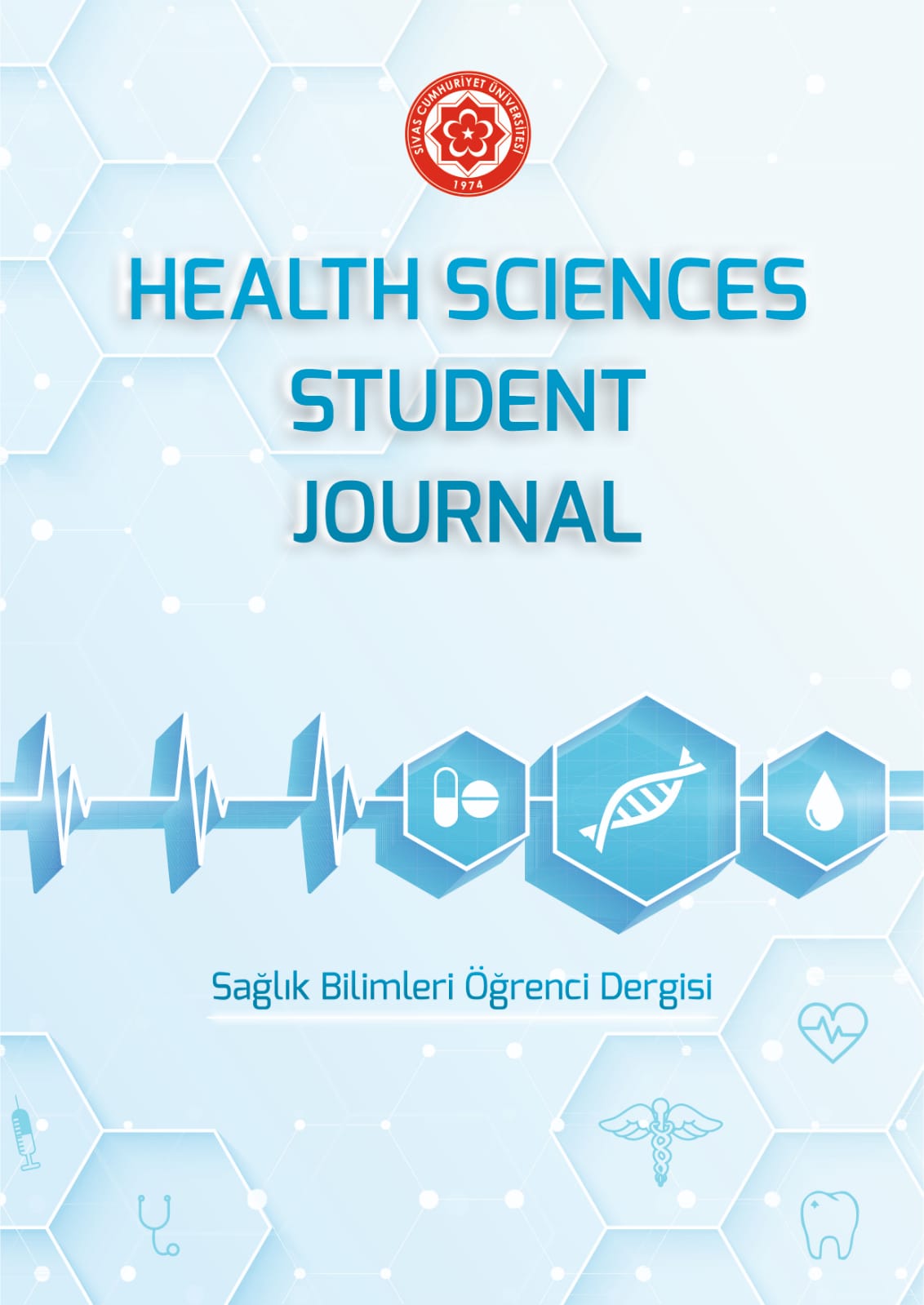![]()
Investigation of the effect of seftriaxone on glutamate excitotoxicity in the C6 glioma cell line
Yazarlar: Talha ÖZSARI1, Bilal ŞAHİN2
Corresponding author
1Talha ÖZSARI, Sivas Cumhuriyet Üniversitesi Tıp Fakültesi, Dönem 3, Sivas, Türkiye
E-mail: talhaozsari@gmail.com
Other authors
2Sivas Cumhuriyet Üniversitesi Tıp Fakültesi, Fizyoloji Anabilim Dalı, Sivas, Türkiye
ÖZET
Amaç: Antidepresan ilaçlar son zamanlarda toksisite üzerine olan etkisi ile ön plana çıkmaktadır. Bu çalışmada amacımız bir antidepresan olan vilazodonun glutamat toksisitesindeki etkisini SH-SY5Y nöroblastom hücreleri üzerinde araştırmaktır.
Yöntem: SH-SY5Y hücre kültüründe kontrol grubu, ilaç grubu, glutamat grubu ve ilaç+glutamat grubu olmak üzere 4 grup planlanmıştır. Kontrol grubuna herhangi bir uygulama yapılmazken ilaç grubuna çeşitli konsantrasyonlarda (1; 0,5; 0,25; 0,1; 0,05 ng/ml) vilazodon 24 saat boyunca uygulanmıştır. XTT hücre canlılığı testi ile vilazodonun hücre proliferasyonu üzerine etkisi belirlenmiştir. Vilazodonun oksidatif stres üzerine etkilerini değerlendirmek için de nNOS, NO, TAS ve TOS ölçümü yapılmıştır.
Bulgular: Elde edilen veriler, vilazodonun uygulanan dozlarda, SH-SY5Y hücrelerinde hücre canlılığı, nNOS, NO, TAS ve TOS parametrelerine istatistiksel olarak anlamlı bir etkisi bulunmamıştır (p>0,05).
Sonuçlar: Bu çalışmanın sonuçları değerlendirildiğinde, vilazodonun SH-SY5Y nöroblastom hücre hattında hücre canlılığı üzerine etkisi gözlenmemiştir. Bu etkisizlik durumu uygulanan vilazodon dozu ile ilişkilendirilebilir.
Anahtar Kelimeler: Toksisite, Vilazodon, Hücre canlılığı, Oksidatif stres, SH-SY5Y nöroblastom.
ABSTRACT
Objective: Antidepressant drugs have recently come to the fore with their effects on toxicity. Our aim in this study is to investigate the effect of vilazodone, an antidepressant, on glutamate toxicity on SH-SY5Y neuroblastoma cells.
Method: In SH-SY5Y cell culture, 2 groups were planned as the control group and the drug group. While no application was made to the control group, various concentrations of vilazodon (1; 0.5; 0,25; 0,1; 0,05 ng/ml) were administered to the drug group for 24 hours. The effect of vilazodone on cell proliferation was determined by the XTT cell viability test. Furthermore; nNOS, NO, TAS and TOS measurements were made to evaluate their effects on oxidative stress.
Results: The data obtained showed no statistically significant effect of vilazodone at the doses we studied on the parameters of cell viability, nNOS, NO, TAS and TOS in SH-SY5Y neuroblastoma and cells (p>0.05).
Conclusions: When the results of this study were evaluated, no effect of vilazodone on cell viability was observed in the SH-SY5Y neuroblastoma cell line. This ineffectiveness may be related to the dose of vilazodone administered.
Keywords: Glutamate, Toxicity, Vilazodone, cell viability, Oxidative stress, SH-SY5Y neuroblastoma.
How to Cite (APA 7)
Ozsari, T., Şahin, B. (2022). SH-SY5Y Nöroblastoma Hücrelerinde Oluşturulan Glutamat Eksitotoksisitesi Modelinde Vilazodonun Etkisinin Araştırılması. Health Sciences Student Journal, 2(2), 35-39. https://www.healthssj.com/sh-sy5y-noroblastoma-hucrelerinde-olusturulan-glutamat-eksitotoksisitesi-modelinde-vilazodonun-etkisinin-arastirilmasi/
KAYNAKLAR
1- Lai, T. W., Zhang, S., Wang, Y. T. 2014, Nisan 1. “Excitotoxicity and stroke: Identifying novel targets for neuroprotection”. Progress in Neurobiology. Elsevier Ltd.
2- Lau, A., Tymianski, M. 2010. “Glutamate receptors, neurotoxicity and neurodegeneration”. Pflugers Archiv European Journal of Physiology
3- Kritis, A. A., Stamoula, E. G., Paniskaki, K. A., Vavilis, T. D. 2015. “Researching glutamate – induced cytotoxicity in different cell lines: A comparative/collective analysis/study”. Frontiers in Cellular Neuroscience, 9, 91.
4- Chen, T., Fei, F., Jiang, X. F., Zhang, L., Qu, Y., Huo, K., Fei, Z. 2012. “Down-regulation of Homer1b/c attenuates glutamate-mediated excitotoxicity through endoplasmic reticulum and mitochondria pathways in rat cortical neurons”. Free Radical Biology and Medicine, 52(1), 208–217.
5- Greenwood, S. M., Connolly, C. N. 2007, Aralık 1. “Dendritic and mitochondrial changes during glutamate excitotoxicity”. Neuropharmacology. Pergamon
6- Reiner, A., Levitz, J. 2018, Haziran 27. “Glutamatergic Signaling in the Central Nervous System: Ionotropic and Metabotropic Receptors in Concert”. Neuron. Cell Press.
7- Maragakis, N. J., Rothstein, J. D. 2001, Mart 1. “Glutamate transporters in neurologic disease”. Archives of Neurology. American Medical Association.
8- Rameaut, G. A., Chiu, L. Y., Ziff, E. B. 2004. “Bidirectional Regulation of Neuronal Nitric-oxide Synthase Phosphorylation at Serine 847 by the N-Methyl-D-aspartate Receptor”. Journal of Biological Chemistry.
9- Hynd, M. R., Scott, H. L., Dodd, P. R. 2004. “Glutamate-mediated excitotoxicity and neurodegeneration in Alzheimer’s disease”. Neurochemistry International.
10- Pitt, D., Werner, P., Raine, C. S. 2000. “Glutamate excitotoxicity in a model of multiple sclerosis”. Nature Medicine.
11- Vincent, P., Mulle, C. 2009. “Kainate receptors in epilepsy and excitotoxicity”. Neuroscience.
12- Park, E., Gim, J., Kim, D. K., Kim, C. S., Chun, H. S. 2019. “Protective effects of alpha-lipoic acid on glutamate-induced cytotoxicity in c6 glioma cells”. Biological and Pharmaceutical Bulletin.
13- Dawson, L. A., Watson, J. M. 2009. “Vilazodone: A 5-HT1A receptor agonist/serotonin transporter inhibitor for the treatment of affective disorders”. CNS Neuroscience and Therapeutics, 15(2), 107–117.
14- Pehrson, A., & Sanchez, C. (2014). Serotonergic modulation of glutamate neurotransmission as a strategy for treating depression and cognitive dysfunction. CNS Spectrums, 19(2), 121-133. doi:10.1017/S1092852913000540
15- Sophie R. Cohen, Michelle L. Terry, 2022 “The multimodal serotonin campound Vilazodone alone induced dyskinesia in hemiparkinsonian rats.”
16- A.Jaso, Brittany, J. Niçin, Mark, 2017, “therapeutic modulation of glutamate reseptör in Major depressive dicorder
